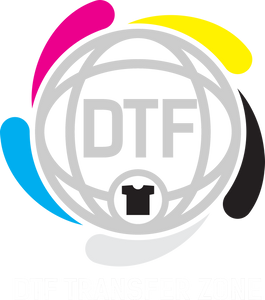Introduction

Direct to Film (DTF) printing has emerged as a popular and efficient method in the printing industry, allowing for high-quality and vibrant prints on a variety of materials. For businesses venturing into DTF printing, it is crucial to invest in the right supplies, ensuring consistent results and long-term success.
DTF Printer
A critical component of any DTF printing business is the DTF printer itself. These specialized printers play a vital role in the printing process, as they transfer high-quality digital designs onto PET films, which are then applied to various materials.
When selecting the right DTF printer for your business, there are several factors to consider. First, consider the printer's print resolution, as a higher resolution will result in more detailed and vibrant prints. Additionally, evaluate the printer's compatibility with different types of DTF inks, as well as its printing speed, which can impact productivity.
Investing in a high-quality DTF printer is essential for achieving consistent and professional results. By choosing a reliable and efficient printer, your business can produce stunning DTF transfers, ultimately leading to increased customer satisfaction and business growth.
PET Films
Polyethylene Terephthalate (PET) films play a crucial role in DTF printing. These films act as the transfer medium for digital designs, allowing for precise and vibrant prints onto various materials. With the importance of PET films in the DTF printing process, it is essential to understand the different types available and select the best option for your business.
There are several types of PET films designed for DTF transfers, each with unique characteristics. Some films offer better adhesion, while others provide a smoother surface for printing. Additionally, film thickness can vary, with thinner films often resulting in a more comfortable and flexible final product.
To select the best PET films for your business, consider the following tips:
- Research the various types of PET films and their specific attributes to determine which best suits your needs.
- Consider your target market and the types of materials you will be printing on, as some PET films may perform better on specific substrates.
- Test different PET films to evaluate their performance in your specific printing process and equipment.
- Choose a reputable supplier that offers high-quality PET films, ensuring consistent results and customer satisfaction.
By carefully selecting the best PET films for your DTF printing business, you can ensure high-quality transfers, ultimately leading to increased customer satisfaction and business growth.
DTF Printing Software
Using the right software for creating and editing designs is of paramount importance in the DTF printing business. The software you choose will have a direct impact on the quality and efficiency of your printing process, ultimately affecting customer satisfaction and business success.
There are several popular DTF printing software options available in the market, each catering to different needs and preferences. Some well-known options include Adobe Illustrator, CorelDRAW, and RIP software specifically designed for DTF printing, such as Kothari Print Pro and DTGPRO. When selecting the appropriate software for your business, consider the following features:
- Compatibility with your DTF printer and other equipment to ensure seamless integration and operation.
- Support for various file formats, allowing you to work with a wide range of design files and ensure optimal print quality.
- Ease of use and learning curve, as this will impact the efficiency of your workflow and the ability of your team to adapt to the software.
- Customization options, including color management and print settings, enabling you to fine-tune the printing process to achieve desired results.
- Technical support and updates, as prompt assistance and access to the latest features will contribute to the smooth operation of your DTF printing business.
Investing in a robust and feature-rich DTF printing software is crucial for ensuring the success of your business. By carefully evaluating the available options and selecting the best software that meets your requirements, you can create stunning DTF transfers that will delight your customers and drive business growth.
DTF Printing Inks
Understanding the different types of DTF inks available is crucial for any DTF printing business, as the quality of the ink directly affects the vibrancy and longevity of the prints. In the market, you will find various inks catering to diverse printing needs and preferences.
When choosing the right DTF ink for your business, consider the following factors:
- Compatibility with your DTF printer, ensuring seamless operation and optimal print quality.
- Color gamut and saturation, as a broader color range and higher saturation will result in more vibrant prints.
- Lightfastness, which refers to the ink's resistance to fading when exposed to light. Higher lightfastness ensures longer-lasting prints.
- Eco-friendliness and safety, as using environmentally friendly and non-toxic inks can contribute to a safer workplace and a positive brand image.
- Cost-effectiveness, as the price of the ink will impact your overall operating costs and profit margins.
Using high-quality DTF inks is essential for achieving vibrant and long-lasting prints that will impress your customers and drive business growth. By carefully evaluating the available options and selecting the best inks for your needs, you can ensure consistent results and maintain a competitive edge in the DTF printing industry.
Hot-Melt Adhesive Powder
In the DTF printing process, hot-melt adhesive powder plays a crucial role in ensuring the successful transfer of digital designs onto various materials. The adhesive powder is applied to the printed PET film, creating a bond between the design and the material being printed on. With its significance in the DTF printing process, understanding the different types of adhesive powders available and selecting the best option for your business is essential.
There are several types of hot-melt adhesive powders in the market, each catering to diverse printing needs and preferences. Some adhesive powders offer better adhesion, while others provide better washability and durability. Additionally, the particle size of the adhesive powder can impact the final print quality and the ease of application.
To select the best hot-melt adhesive powder for your DTF printing business, consider the following tips:
- Research the various types of adhesive powders and their specific attributes to determine which best suits your needs.
- Consider the types of materials you will be printing on, as some adhesive powders may perform better on specific substrates.
- Test different adhesive powders to evaluate their performance in your specific printing process and equipment.
- Choose a reputable supplier that offers high-quality adhesive powders, ensuring consistent results and customer satisfaction.
By carefully selecting the best hot-melt adhesive powder for your DTF printing business, you can ensure high-quality transfers, ultimately leading to increased customer satisfaction and business growth.
Automatic Powder Shaker
Utilizing an automatic powder shaker in the DTF printing process can greatly improve efficiency and contribute to consistent results. This essential piece of equipment ensures that the hot-melt adhesive powder is applied evenly across the printed PET film, creating a strong bond between the design and the material being printed on.
There are various types of powder shakers available in the market, each catering to different business needs and preferences. Some shakers offer greater precision in powder application, while others focus on speed and efficiency. To choose the right powder shaker for your DTF printing business, take the following factors into account:
- Consider the size and design of the powder shaker, as this can impact its compatibility with your workspace and other equipment.
- Evaluate the shaker's speed and efficiency, as this will directly affect your overall productivity.
- Research the ease of use and maintenance of the powder shaker, as this can contribute to a smoother workflow and reduced downtime.
- Choose a reputable supplier that offers high-quality powder shakers, ensuring reliable performance and customer satisfaction.
Investing in a suitable automatic powder shaker for your DTF printing business can significantly enhance the quality and consistency of your transfers, leading to increased customer satisfaction and business growth.
Heat Press Machine or Curing Oven
Both heat press machines and curing ovens play a vital role in the DTF printing process, as they are responsible for activating the adhesive powder and ensuring the successful transfer of digital designs onto various materials. Understanding the differences between these two types of equipment and selecting the right one for your business is crucial for achieving optimal results.
Heat press machines apply heat and pressure directly onto the printed PET film, activating the adhesive powder and creating a bond between the design and the material being printed on. These machines are popular for their ease of use, speed, and ability to produce high-quality transfers on a wide range of materials. On the other hand, curing ovens use indirect heat to activate the adhesive powder, offering more precise temperature control and the potential for better overall print quality. However, curing ovens can be more complex to operate and may require a larger investment upfront.
To select the right equipment for your DTF printing business, consider the following factors:
- Assess the volume of your print production and the types of materials you will be working with, as this can help you determine whether a heat press machine or curing oven is more suitable for your needs.
- Consider the available space in your workspace, as curing ovens can be significantly larger than heat press machines and may require additional ventilation.
- Evaluate the ease of use, maintenance, and overall cost of ownership for each type of equipment, as this can impact your overall productivity and profitability.
- Choose a reputable supplier that offers high-quality equipment, ensuring reliable performance and customer satisfaction.
By carefully evaluating your business needs and selecting the appropriate heat press machine or curing oven, you can ensure consistent, high-quality DTF transfers that will delight your customers and drive business growth.
Quality Control Tools
Quality control is a critical aspect of the DTF printing process, as it ensures that the final products meet both your business's standards and your customers' expectations. Implementing effective quality control measures can help you maintain consistent and high-quality prints, ultimately leading to increased customer satisfaction and business growth.
There are various tools and equipment used for quality control in DTF printing, including:
- Colorimeters and spectrophotometers for measuring color accuracy and consistency across prints.
- Tension meters for ensuring proper tension in the PET film during the printing process.
- Surface roughness testers for assessing the smoothness and uniformity of the printed surface.
- Adhesion testers for evaluating the bond strength between the printed design and the material.
To ensure consistent and high-quality prints, consider the following tips:
- Regularly calibrate and maintain your DTF printer, as well as any quality control equipment, to ensure accurate and reliable performance.
- Establish a comprehensive quality control process that includes pre-print checks, in-process inspections, and post-print assessments.
- Train your team in proper quality control procedures and the use of relevant tools and equipment, fostering a culture of quality within your business.
- Monitor and analyze quality control data to identify trends and areas for improvement, allowing you to continuously refine your processes and produce exceptional DTF transfers.
By implementing effective quality control measures and leveraging the appropriate tools and equipment, you can maintain the highest standards in your DTF printing business and consistently deliver outstanding results to your customers.
Empower Your DTF Business
In this guide, we've covered the essential supplies needed for a successful DTF printing business, emphasizing the importance of investing in quality equipment and materials. These key supplies, including DTF printers, PET films, printing software, inks, adhesive powder, powder shakers, and heat press machines or curing ovens, will ensure that your business produces consistent, high-quality prints that keep customers coming back. For all your DTF printing needs, including custom DTF transfers, DTF inks, and DTF supplies, trust DTF Transfer Zone to deliver excellence. Visit us today and propel your DTF printing business to new heights!

